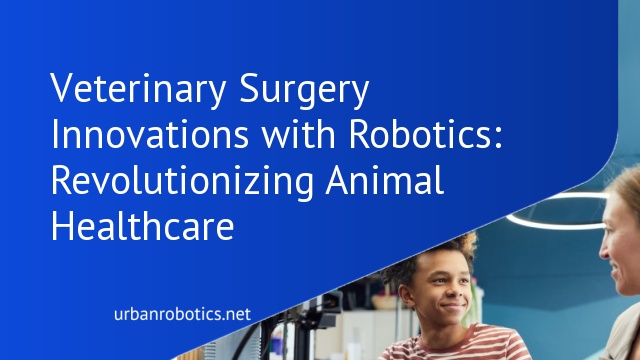Evolution Of Veterinary Surgery
Veterinary surgery has progressed significantly over the past few decades. Previously, traditional methods dominated, often involving large incisions and prolonged recovery times. The introduction of minimally invasive techniques, such as laparoscopy, marked a pivotal shift. These methods reduced both surgical trauma and healing periods, leading to better patient outcomes.
More recently, robotics has emerged as a transformative force in veterinary surgery. Robotic-assisted procedures enhance precision, particularly in complex surgeries. Surgeons can manipulate robotic instruments with unparalleled accuracy, minimizing the risk of complications. For example, robotic systems in procedures like spinal surgery offer micro-level control, reducing damage to surrounding tissues.
These advancements align with our aim to provide superior veterinary care. The integration of robotics not only enhances surgical capabilities but also sets new benchmarks for the entire veterinary field. As we look ahead, continuous innovation in this area promises to further improve animal health and recovery experience for pets.
Introduction To Robotics In Veterinary Surgery
Robotics have revolutionized veterinary surgery, offering unprecedented precision and control. These advancements are transforming traditional practices and elevating standards in animal healthcare.
What Is Robotic Surgery?
Robotic surgery utilizes robotic systems to perform surgical procedures, controlled by a surgeon through a computer interface. This technology offers enhanced dexterity and fine motor control compared to human hands. In veterinary medicine, robotic-assisted surgery is employed for complex and delicate operations, providing a minimally invasive approach and reducing the physical strain on the surgeon.
Benefits Over Traditional Surgery
Robotic surgery provides numerous advantages over traditional methods, such as increased precision, which is critical in delicate procedures. This technology minimizes surgical trauma, leading to shorter recovery times and less postoperative pain for animals. Additionally, it reduces the risk of complications and infection due to smaller incisions, significantly improving overall surgical outcomes.
Key Innovations In Robotic Veterinary Surgery
Robotic technology has introduced groundbreaking innovations in veterinary surgery. We will explore key advancements shaping the future of animal healthcare.
Minimally Invasive Procedures
Minimally invasive procedures, often utilized in veterinary surgery, leverage robotic systems. These procedures result in smaller incisions, reducing recovery time and trauma for animals. Robotic-assisted surgeries, such as laparoscopies and thoracoscopies, allow veterinarians to operate with increased accuracy, minimizing the risk of complications. This innovation not only enhances animal welfare but also leads to quicker postoperative recovery.
Enhanced Precision And Control
Enhanced precision and control are significant benefits of robotic veterinary surgery. Robotics enable veterinarians to perform complex surgeries with a degree of accuracy unattainable by human hands alone. Utilizing a computer interface, surgeons can manipulate robotic instruments with fine motor control, significantly improving outcomes for intricate procedures. This increased precision reduces the likelihood of surgical errors, ensuring safer and more effective treatments for animals.
Case Studies And Real-World Applications
Veterinary surgery using robotics has shown tremendous potential. Here, we explore specific instances demonstrating these advancements and discuss current hurdles.
Success Stories
Several veterinary surgeries highlight the effectiveness of robotics. In one notable case, a dog with a complex liver tumor underwent successful robotic-assisted surgery. The procedure minimized trauma, and the dog experienced a rapid recovery. Another example involved a cat with a severe heart defect. Utilizing robotic technology, the surgery was performed with heightened precision, resulting in a quick postoperative recovery and significantly reduced complications. These cases exemplify the transformative impact of robotics in veterinary surgery.
Current Limitations And Challenges
Despite the benefits, some limitations of robotic veterinary surgery exist. High costs associated with robotic systems can hinder widespread adoption among veterinary practices. Additionally, the learning curve for veterinary surgeons can be steep. Specialized training and experience are necessary to optimize the use of robotic technology. Connectivity issues also pose a challenge in remote or resource-limited areas, making it difficult to access and use these advanced systems effectively. These challenges must be addressed to fully realize the potential of robotics in veterinary surgery.
Future Prospects And Emerging Trends
The future of veterinary surgery lies in advancements in robotics. Emerging technologies and ongoing research promise to reshape this medical field.
Ongoing Research And Development
Robotics research in veterinary surgery focuses on enhancing precision, adaptability, and ease of use. Innovations include improved robotic arms for increased dexterity and AI-driven systems for real-time adjustments. Researchers explore integrating machine learning algorithms to help predict and avoid complications during surgeries. These advancements aim to create more intuitive interfaces, streamlined procedures, and ultimately, better outcomes for animals.
Potential Impact On Veterinary Practice
The integration of advanced robotics can revolutionize veterinary practices. Robotic systems reduce surgery times and enhance patient recovery rates. They lower costs over time by minimizing complications and reducing the need for extended postoperative care. Practices can offer a wider range of procedures, making advanced care accessible in more locations. The potential widespread adoption of these technologies can lead to a new standard in animal healthcare, improving surgical outcomes and broader access to sophisticated medical interventions.
Conclusion
Robotic innovations in veterinary surgery are setting the stage for a transformative era in animal healthcare. As technology advances, we’re likely to see even greater precision and efficiency in surgical procedures. The potential for reduced surgery times and enhanced recovery rates is promising.
While challenges remain, ongoing research and development continue to pave the way for more accessible and cost-effective solutions. By embracing these advancements, we can look forward to a future where our pets receive the highest standard of care possible.





